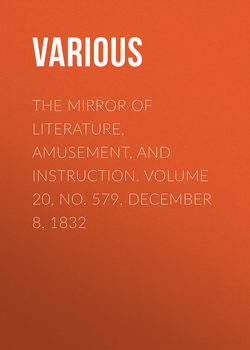The Mirror of Literature, Amusement, and Instruction. Volume 20, No. 579, December 8, 1832

Реклама. ООО «ЛитРес», ИНН: 7719571260.
Отрывок из книги
This Engraving may prove a welcome pictorial accompaniment to a score of plans of "the seat of war," in illustration of the leading topic of the day. The view may be relied on for accuracy; it being a transfer of the engraving in "Select Views of the Principal Cities of Europe, from Original Paintings, by Lieutenant Colonel Batty, F.R.S.1" We have so recently described the city, that our present notice must be confined to a brief outline.
Antwerp, one of the chief cities of the Netherlands, is situated on the river Scheldt, 22 miles north of Brussels, and 65 south of Amsterdam: longitude 4° 23' East; latitude 51° 13' North. It is called by Latin writers, Antverpia, or Andoverpum; by the Germans, Antorf; by the Spanish, Anveres; and by the French, Anvers.2 The city is of great antiquity, and is supposed by some to have existed before the time of Cæsar. It was much enlarged by John, the first Duke of Brabant, in 1201; by John, the third, in 1314; and by the Emperor Charles V. in 1543: it has always been a place of commercial importance, and about twenty years after the last mentioned date, the trade is concluded to have been at its greatest height; the number of inhabitants was then computed at 200,000. A few years subsequently, Antwerp suffered much in the infamous war against religious freedom, projected by the detestable Philip II. (son of Charles V.) and executed by the sanguinary Duke of Alva, whose cruelty has scarcely a parallel in history. In this merciless crusade, Alva boasted that he had consigned 18,000 persons to the executioner; and with vanity as disgusting as his cruelty, he placed a statue of himself in Antwerp, in which he was figured trampling on the necks of two statues, representing the two estates of the Low Countries. Before the termination of the war, not less than 600 houses in the city were burnt, and 6 or 7,000 of the inhabitants killed or drowned. Antwerp was retaken and repaired by the Prince of Parma, in 1585. It has since that time been captured and re-captured so frequently as to render its decreasing prosperity a sad lesson, if such proof were wanting, of the baleful scourge of war. The reader need scarcely be reminded that the last and severest blow to the prosperity of Antwerp was occasioned by the overthrow of Buonaparte, when, by the treaty of peace signed in 1814, her naval establishment was utterly destroyed.3 The population has dwindled to little more than one-fourth of the original number, its present number scarcely exceeding 60,000.
.....
The distance from the mouth of the Scheldt to Antwerp is usually reckoned to be sixty-two miles, allowing for the bending of the river. At Lillo, an important fortress, the appearance of the city of Antwerp becomes an interesting object, and the more imposing the nearer the traveller approaches along the last reach of the Scheldt.
Antwerp has been the birthplace of many learned men—as, Ortelius, an eminent mathematician and antiquary of the sixteenth century, and the friend of our Camden; Gorleus, a celebrated medallist, of the same period; Andrew Schott, a learned Jesuit, and the friend of Scaliger; Lewis Nonnius, a distinguished physician and erudite scholar, born early in the seventeenth century. Few places have produced so many painters of merit, as will be seen at page 380, by a well-timed communication from our early correspondent P.T.W.
.....